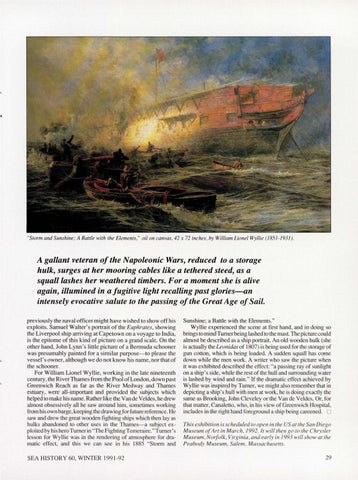"Storm and Sunshine; A Battle with the Elements ," oil on canvas , 42 x 72 inches, by William Lionel Wyllie (1851-1931).
A gallant veteran of the Napoleonic Wars, reduced to a storage hulk, surges at her mooring cables like a tethered steed, as a squall lashes her weathered timbers. For a moment she is alive again, illumined in a fugitive light recalling past glories-an intensely evocative salute to the passing of the Great Age of Sail. previously the naval officer might have wished to show off his exploits. Samuel Walter's portrait of the Euphrates, showing the Liverpool ship arriving at Capetown on a voyage to India, is the epitome of this kind of picture on a grand scale. On the other hand, John Lynn 's little picture of a Bermuda schooner was presumably painted for a similar purpose-to please the vessel's owner, although we do not know his name, nor that of the schooner. For William Lionel Wyllie, working in the late nineteenth century, the River Thames from the Pool of London, down past Greenwich Reach as far as the River Medway and Thames estuary, were all-important and provided the subjects which helped to make his name. Rather like the Van de Ve Ides, he drew almost obsessively all he saw around him, sometimes working from his own barge, keeping the drawing for future reference. He saw and drew the great wooden fighting ships which then lay as hulks abandoned to other uses in the Thames-a subject exploited by his hero Turner in "The FightingTemeralre." Turner's lesson for Wyllie was in the rendering of atmosphere for dramatic effect, and this we can see in his 1885 "Storm and SEA HISTORY 60, WINTER 1991-92
Sunshine; a Battle with the Elements." Wyllie experienced the scene at first hand, and in doing so brings to mind Turner being lashed to the mast. The picture could almost be described as a ship portrait. An old wooden hulk (she is actually the Leonidas of 1807) is being used for the storage of gun cotton, which is being loaded. A sudden squall has come down while the men work. A writer who saw the picture when it was exhibited described the effect: "a passing ray of sunlight on a ship's side, while the rest of the hull and surrounding water is lashed by wind and rain." If the dramatic effect achieved by Wyllie was inspired by Turner, we might also remember that in depicting a ship's hull with men at work, he is doing exactly the same as Brooking, John Cleveley or the Van de Veldes. Or, for that matter, Canaletto, who, in his view of Greenwich Hospital, includes in the right hand foreground a ship being careened. O This exhibition is scheduled to open in the US at the San Diego Museum ofArt in March, 1992. lt will then go to the Chrysler Museum , N01folk, Virginia, and early in 1993 will show at the Peabody Museum, Salem, Massachusetts.
29
